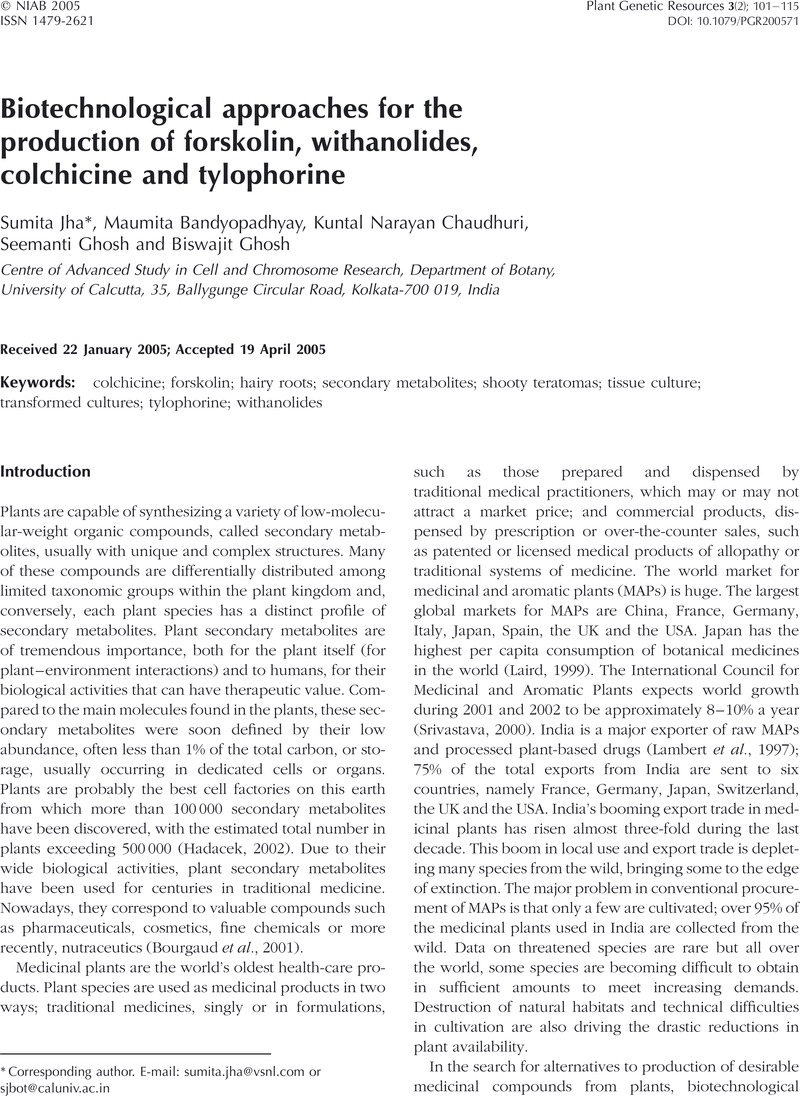Crossref Citations
This article has been cited by the following publications. This list is generated based on data provided by Crossref.
Mukhopadhyay, Madhumita J.
and
Mukhopadhyay, Sandip
2008.
A Biotechnological Approach for Enhancement of Colchicine Accumulation in Iphigenia indica Kunth.
Journal of Plant Biochemistry and Biotechnology,
Vol. 17,
Issue. 2,
p.
185.
Pomilio, Alicia B.
Falzoni, Elvira M.
and
Vitale, Arturo A.
2008.
Toxic Chemical Compounds of the Solanaceae.
Natural Product Communications,
Vol. 3,
Issue. 4,
Misico, Rosana I.
Nicotra, Viviana E.
Oberti, Juan C.
Barboza, Gloria
Gil, Roberto R.
and
Burton, Gerardo
2011.
Progress in the Chemistry of Organic Natural Products Vol. 94.
Vol. 94,
Issue. ,
p.
127.
Arumugam, A.
and
Gopinath, K.
2012.
In vitro Micropropagation using Corm Bud Explants: An Endangered Medicinal Plant of Gloriosa superba L..
Asian Journal of Biotechnology,
Vol. 4,
Issue. 3,
p.
120.
Tiwari, Ruchi
Chakrabort, Sandip
Saminathan, Mani
Dhama, Kuldeep
and
Singh, Shoor Vir
2014.
Ashwagandha (Withania somnifera): Role in Safeguarding Health, Immunomodulatory
Effects, Combating Infections and Therapeutic Applications: A Review.
Journal of Biological Sciences,
Vol. 14,
Issue. 2,
p.
77.
Paul, Pijush
Sarkar, Sayantika
and
Jha, Sumita
2015.
Effects associated with insertion of cryptogein gene utilizing Ri and Ti plasmids on morphology and secondary metabolites are stable in Bacopa monnieri-transformed plants grown in vitro and ex vitro.
Plant Biotechnology Reports,
Vol. 9,
Issue. 4,
p.
231.
Roychowdhury, Dipasree
Chaubey, Binay
and
Jha, Sumita
2015.
The Fate of Integrated Ri T-DNA rol Genes during Regeneration via Somatic Embryogenesis in Tylophora indica.
Journal of Botany,
Vol. 2015,
Issue. ,
p.
1.
Teixeira da Silva, Jaime A.
and
Jha, Sumita
2016.
Micropropagation and genetic transformation of Tylophora indica (Burm. f.) Merr.: a review.
Plant Cell Reports,
Vol. 35,
Issue. 11,
p.
2207.
Halder, Mihir
and
Jha, Sumita
2016.
Enhanced trans-resveratrol production in genetically transformed root cultures of Peanut (Arachis hypogaea L.).
Plant Cell, Tissue and Organ Culture (PCTOC),
Vol. 124,
Issue. 3,
p.
555.
Korkina, Liudmila
Mayer, Wolfgang
and
De Luca, Chiara
2017.
Meristem Plant Cells as a Sustainable Source of Redox Actives for Skin Rejuvenation.
Biomolecules,
Vol. 7,
Issue. 2,
p.
40.
Isah, Tasiu
Umar, Shahid
Mujib, Abdul
Sharma, Maheshwar Prasad
Rajasekharan, P. E.
Zafar, Nadia
and
Frukh, Arajmand
2018.
Secondary metabolism of pharmaceuticals in the plant in vitro cultures: strategies, approaches, and limitations to achieving higher yield.
Plant Cell, Tissue and Organ Culture (PCTOC),
Vol. 132,
Issue. 2,
p.
239.
Halder, Mihir
and
Jha, Sumita
2020.
Plant Cell and Tissue Differentiation and Secondary Metabolites.
p.
1.
Halder, Mihir
and
Jha, Sumita
2020.
Plant Cell and Tissue Differentiation and Secondary Metabolites.
p.
1.
Halder, Mihir
and
Jha, Sumita
2021.
Plant Cell and Tissue Differentiation and Secondary Metabolites.
p.
663.
Dorrazehi, M.
Allahdou, M.
Fakheri, B. A.
and
Mehravaran, L.
2024.
Elicitation Improves the Production of Bioactive Compounds and Antioxidant Activity in Cell Suspension Culture of Withania coagulans (Stocks) Dunal.
Russian Journal of Plant Physiology,
Vol. 71,
Issue. 1,
Joshi, Bhuwan Chandra
Durgapal, Sumit
Mukhija, Minky
and
Bhargava, Anurag
2024.
An overview on the phytopharmacological insights into Gloriosa superba L. (Kalahari): a promising endangered plant species.
Discover Plants,
Vol. 1,
Issue. 1,
Prashant, Shera Pandit
and
Bhawana, Mishra
2024.
An update on biotechnological intervention mediated by plant tissue culture to boost secondary metabolite production in medicinal and aromatic plants.
Physiologia Plantarum,
Vol. 176,
Issue. 4,



